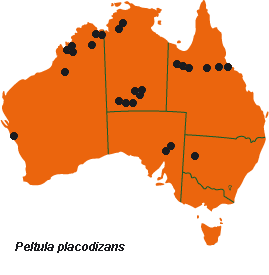



Australian Biological Resources Study
| Checklist of the Lichens of Australia and its Island Territories | ||
| Introduction | A–D | E–O | P–R | S–Z | Oceanic Islands | References | ||
| Peltula placodizans (Zahlbr.) Wetmore | ||
| Ann. Missouri Bot. Gard. 57: 196 ('1970') [1971]; Heppia placodizans Zahlbr., Bull. Torrey Bot. Club 35: 299 (1908). T: Station II, Tumamoc Hill, Tucson, Arizona, U.S.A., 1908, Blumer; holo: W. | ||
| Thallus compound, areolate in the centre, effigurate-lobate at the margin; central squamules erect, cylindrical, plane or convex and often sorediate at the top, brownish to olive-green, to 1.3 mm tall, 0.1–0.5 mm thick. Upper cortex absent; epinecral layer 8–15 µm thick, yellowish. Medulla composed of loosely interwoven hyphae with globose to elongate cells, with numerous air spaces; photobiont layer 50–90 µm thick. Lower cortex poorly developed, paraplectenchymatous, 20–40 µm thick, with globose hyphal cells 3–8 µm diam. Apothecia rare, immersed, usually 1 per squamule, restricted to central squamules; disc punctiform, to 0.3 mm diam., yellowish brown to blackish brown; hymenium wine-red in iodine. Asci clavate to obclavate; walls orange in iodine, blue after pretreatment with KOH. Ascospores more than 64 per ascus, globose to ellipsoidal, 4.5–8 × 3–4.5 µm. Pycnidia immersed, simple, globose; conidia fusiform, 3.5 × 1.5 µm. |  |
|
| Occurs in W.A., N.T., S.A., Qld and N.S.W.; grows on acidic rocks in desert and other arid habitats, frequently in places that receive some shade. Also in South America, south-western North America, Africa and Europe. | ||
| Büdel (2001) | ||
| Checklist Index |
| Introduction | A–D | E–O | P–R | S–Z | Oceanic Islands | References |
This work is copyright. Apart from any use as permitted under the Copyright Act 1968, no part may be reproduced by any process without prior written permission from Australian Biological Resources Study. Requests and inquiries concerning reproduction and rights should be addressed in the first instance to Dr P. McCarthy. These pages may not be displayed on, or downloaded to, any other server without the express permission of ABRS.